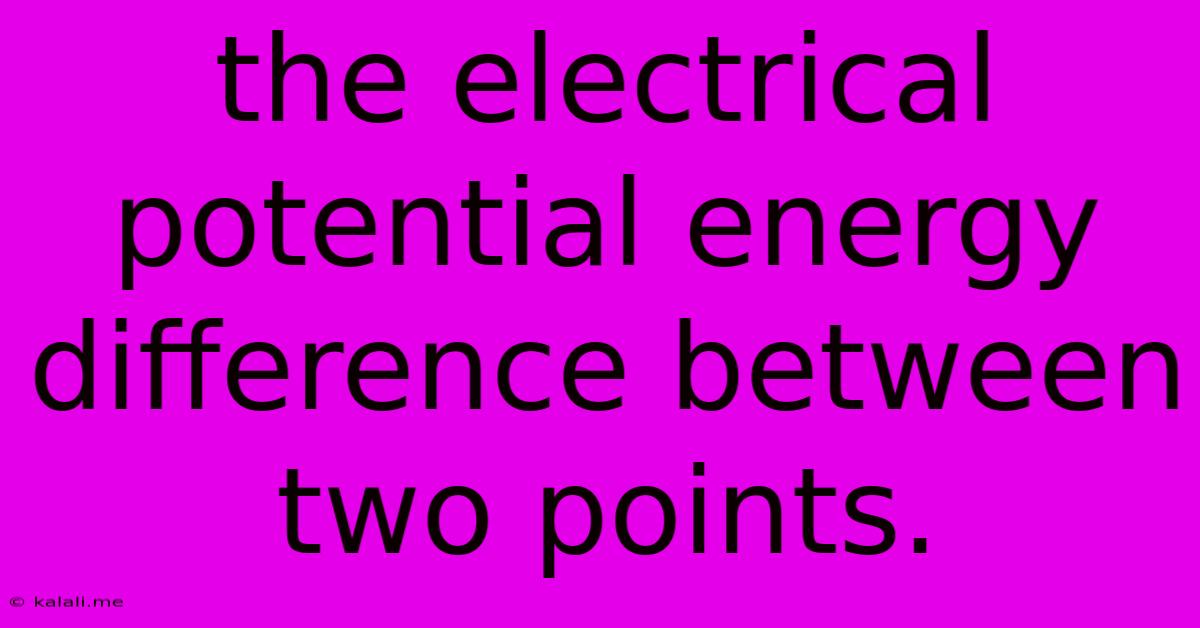The Electrical Potential Energy Difference Between Two Points.
Kalali
Jun 05, 2025 · 3 min read

Table of Contents
Understanding the Electrical Potential Energy Difference Between Two Points
Meta Description: This article explains electrical potential energy difference, its calculation using electric fields and potential, and its significance in circuits and electrostatics. Learn about voltage, its units, and real-world applications.
Electrical potential energy difference, often simplified to potential difference, is a fundamental concept in electromagnetism. It describes the work required to move a charge between two points in an electric field. Understanding this concept is crucial for grasping how circuits work, and for analyzing various electrostatic phenomena. This article will delve into the intricacies of potential difference, exploring its calculation, units, and practical applications.
What is Electrical Potential Energy?
Before diving into the difference, let's define electrical potential energy itself. It's the energy a charged particle possesses due to its position within an electric field. Just like a ball held high above the ground possesses gravitational potential energy, a charge in an electric field possesses electrical potential energy. This energy is directly related to the charge's magnitude and its location relative to other charges creating the field. A positive charge will have higher potential energy when further away from another positive charge (or closer to a negative charge), while a negative charge will have higher potential energy closer to a positive charge.
Calculating Potential Difference
The potential difference (often denoted as ΔV or simply V) between two points, A and B, is the change in electrical potential energy (ΔPE) per unit charge (q) required to move that charge between those points. Mathematically:
ΔV = ΔPE / q
This equation tells us that a larger potential difference means more work is needed to move a charge between those two points. The unit of potential difference is the volt (V), where 1 volt is equal to 1 joule per coulomb (1 J/C). This means that if a potential difference of 1 volt exists between two points, 1 joule of work is required to move a charge of 1 coulomb between them.
Potential Difference and Electric Field
The potential difference is intrinsically linked to the electric field. The electric field strength (E) can be defined as the negative gradient of the electric potential (V):
E = -∇V
This equation highlights the relationship between the electric field's direction and the potential difference. The electric field points from regions of higher potential to regions of lower potential, essentially indicating the direction of the force acting on a positive charge.
Voltage: A Practical Term
In everyday usage, the term "voltage" is frequently used interchangeably with "potential difference." Voltage is the measure of electrical potential difference between two points in a circuit. It drives the flow of charge (current) through the circuit. A higher voltage means a greater driving force for the current.
Applications of Potential Difference
The concept of potential difference has vast applications across various fields:
- Electrical Circuits: Voltage is the fundamental driving force in all electrical circuits, powering everything from small electronics to large power grids.
- Electrostatics: Understanding potential difference is critical in analyzing electrostatic phenomena like capacitor charging and discharging, and the behavior of charged particles in electric fields.
- Medical Imaging: Techniques like electrocardiograms (ECGs) and electroencephalograms (EEGs) measure potential differences in the body to diagnose various medical conditions.
Conclusion
Understanding the electrical potential energy difference between two points is crucial for comprehending the behavior of charges in electric fields and the operation of electrical circuits. By grasping the relationship between potential difference, electric field, and voltage, one can gain a much deeper understanding of electromagnetism and its numerous applications in our daily lives. Further exploration into topics like capacitance and electric current will build upon this fundamental concept.
Latest Posts
Latest Posts
-
Points That Lie On The Same Plane
Jun 06, 2025
-
Energy Budget Equation With Navier Stokes
Jun 06, 2025
-
Did Luke Try To Kill Himself In Empire Strikes Back
Jun 06, 2025
-
Side By Side Fridge Freezer Not Working
Jun 06, 2025
-
How Many Concubines And Wives Did David Have
Jun 06, 2025
Related Post
Thank you for visiting our website which covers about The Electrical Potential Energy Difference Between Two Points. . We hope the information provided has been useful to you. Feel free to contact us if you have any questions or need further assistance. See you next time and don't miss to bookmark.